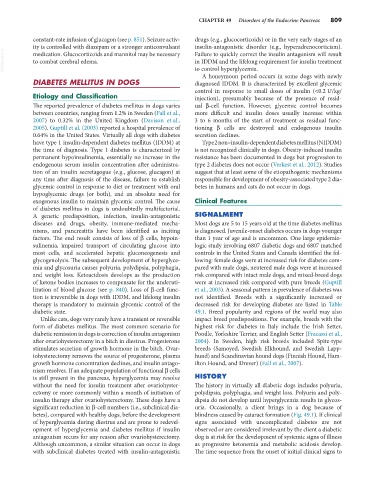Page 837 - Small Animal Internal Medicine, 6th Edition
P. 837
CHAPTER 49 Disorders of the Endocrine Pancreas 809
constant-rate infusion of glucagon (see p. 851). Seizure activ- drugs (e.g., glucocorticoids) or in the very early stages of an
ity is controlled with diazepam or a stronger anticonvulsant insulin-antagonistic disorder (e.g., hyperadrenocorticism).
VetBooks.ir medication. Glucocorticoids and mannitol may be necessary Failure to quickly correct the insulin antagonism will result
in IDDM and the lifelong requirement for insulin treatment
to combat cerebral edema.
to control hyperglycemia.
A honeymoon period occurs in some dogs with newly
DIABETES MELLITUS IN DOGS diagnosed IDDM. It is characterized by excellent glycemic
control in response to small doses of insulin (<0.2 U/kg/
Etiology and Classification injection), presumably because of the presence of resid-
The reported prevalence of diabetes mellitus in dogs varies ual β-cell function. However, glycemic control becomes
between countries, ranging from 1.2% in Sweden (Fall et al., more difficult and insulin doses usually increase within
2007) to 0.32% in the United Kingdom (Davison et al., 3 to 6 months of the start of treatment as residual func-
2005). Guptill et al. (2003) reported a hospital prevalence of tioning β cells are destroyed and endogenous insulin
0.64% in the United States. Virtually all dogs with diabetes secretion declines.
have type 1 insulin-dependent diabetes mellitus (IDDM) at Type 2 non–insulin-dependent diabetes mellitus (NIDDM)
the time of diagnosis. Type 1 diabetes is characterized by is not recognized clinically in dogs. Obesity-induced insulin
permanent hypoinsulinemia, essentially no increase in the resistance has been documented in dogs but progression to
endogenous serum insulin concentration after administra- type 2 diabetes does not occur (Verkest et al., 2012). Studies
tion of an insulin secretagogue (e.g., glucose, glucagon) at suggest that at least some of the etiopathogenic mechanisms
any time after diagnosis of the disease, failure to establish responsible for development of obesity-associated type 2 dia-
glycemic control in response to diet or treatment with oral betes in humans and cats do not occur in dogs.
hypoglycemic drugs (or both), and an absolute need for
exogenous insulin to maintain glycemic control. The cause Clinical Features
of diabetes mellitus in dogs is undoubtedly multifactorial.
A genetic predisposition, infection, insulin-antagonistic SIGNALMENT
diseases and drugs, obesity, immune-mediated mecha- Most dogs are 5 to 15 years old at the time diabetes mellitus
nisms, and pancreatitis have been identified as inciting is diagnosed. Juvenile-onset diabetes occurs in dogs younger
factors. The end result consists of loss of β cells, hypoin- than 1 year of age and is uncommon. One large epidemio-
sulinemia, impaired transport of circulating glucose into logic study involving 6807 diabetic dogs and 6807 matched
most cells, and accelerated hepatic gluconeogenesis and controls in the United States and Canada identified the fol-
glycogenolysis. The subsequent development of hyperglyce- lowing: female dogs were at increased risk for diabetes com-
mia and glycosuria causes polyuria, polydipsia, polyphagia, pared with male dogs, neutered male dogs were at increased
and weight loss. Ketoacidosis develops as the production risk compared with intact male dogs, and mixed-breed dogs
of ketone bodies increases to compensate for the underuti- were at increased risk compared with pure breeds (Guptill
lization of blood glucose (see p. 840). Loss of β-cell func- et al., 2003). A seasonal pattern in prevalence of diabetes was
tion is irreversible in dogs with IDDM, and lifelong insulin not identified. Breeds with a significantly increased or
therapy is mandatory to maintain glycemic control of the decreased risk for developing diabetes are listed in Table
diabetic state. 49.1. Breed popularity and regions of the world may also
Unlike cats, dogs very rarely have a transient or reversible impact breed predispositions. For example, breeds with the
form of diabetes mellitus. The most common scenario for highest risk for diabetes in Italy include the Irish Setter,
diabetic remission in dogs is correction of insulin antagonism Poodle, Yorkshire Terrier, and English Setter (Fracassi et al.,
after ovariohysterectomy in a bitch in diestrus. Progesterone 2004). In Sweden, high risk breeds included Spitz-type
stimulates secretion of growth hormone in the bitch. Ovar- breeds (Samoyed, Swedish Elkhound, and Swedish Lapp-
iohysterectomy removes the source of progesterone, plasma hund) and Scandinavian hound dogs (Finnish Hound, Ham-
growth hormone concentration declines, and insulin antago- ilton Hound, and Drever) (Fall et al., 2007).
nism resolves. If an adequate population of functional β cells
is still present in the pancreas, hyperglycemia may resolve HISTORY
without the need for insulin treatment after ovariohyster- The history in virtually all diabetic dogs includes polyuria,
ectomy or more commonly within a month of initiation of polydipsia, polyphagia, and weight loss. Polyuria and poly-
insulin therapy after ovariohysterectomy. These dogs have a dipsia do not develop until hyperglycemia results in glycos-
significant reduction in β-cell numbers (i.e., subclinical dia- uria. Occasionally, a client brings in a dog because of
betes), compared with healthy dogs, before the development blindness caused by cataract formation (Fig. 49.1). If clinical
of hyperglycemia during diestrus and are prone to redevel- signs associated with uncomplicated diabetes are not
opment of hyperglycemia and diabetes mellitus if insulin observed or are considered irrelevant by the client a diabetic
antagonism recurs for any reason after ovariohysterectomy. dog is at risk for the development of systemic signs of illness
Although uncommon, a similar situation can occur in dogs as progressive ketonemia and metabolic acidosis develop.
with subclinical diabetes treated with insulin-antagonistic The time sequence from the onset of initial clinical signs to

